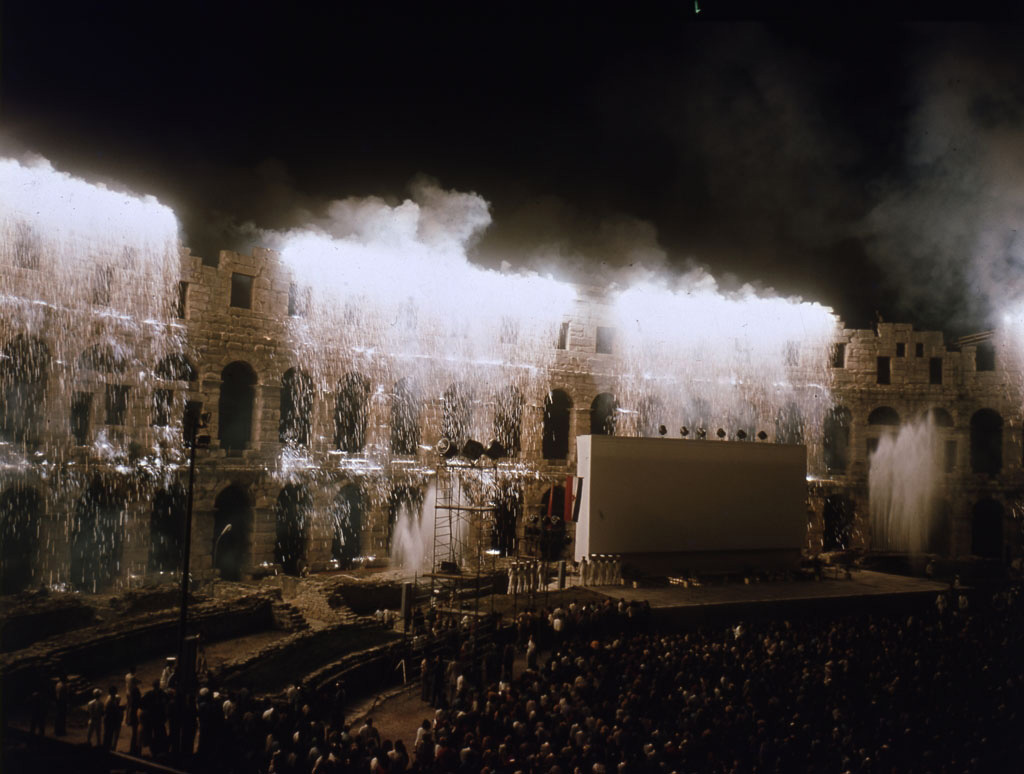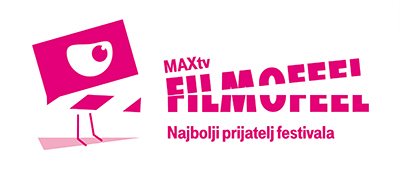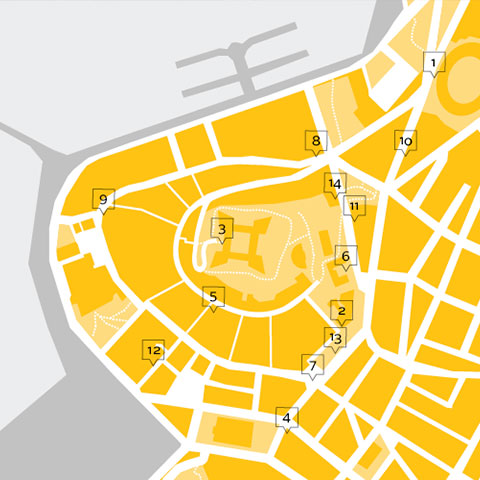|

The sixtieth anniversary of the Pula Film Festival is an event of extreme importance not only for our film industry but also for our culture in general as well. It is the world’s oldest national festival and the festival with the largest average number of visitors per screening, which is due to the enormous auditorium in the Arena, as is the well-preserved Vespasian’s amphitheater dating from the 1st century AD popularly called. However, the first film revue held in this venue took place in 1938, while Pula was under the Italian Fascist rule. This is the reason why this was not a topic of discussion after World War II and few people even remembered the event. Actually, when Marijan Rotar (1927 – 2003), a Slovene, the director of the Pula Film Company, sent to Pula by new authorities to spur the development of culture in the city, came up with a proposal to organize a film revue in the Arena, he met huge resistance based upon the argument that it would be impossible to have film screenings of sufficient technical quality in the Arena. However, in 1953 Rotar succeeded in organizing a revue of foreign hit films with four Hollywood productions, among which Captain Horatio HornblowerR.N. from 1951 by Raoul Walsh, and four non-American films, among which Rashomon (1950) by Akira Kurosawa and We Are All Murderers (Nous sommes tous des assassins, 1952) by André Cayatte. In fact, due to its popularity, the revue was extended to two more evenings with Svet na kajžarju (1952) by Slovene director France Štiglic and nine short animated films.
As many as fifty thousand visitors watched these ten programmes. This fact spurred interest for the event, so the following year Rotar as a director launched the first film festival – a revue of national films organized by the Croatian Cinema Association, Jadran Film from Zagreb and the Pula City Film Company. Six feature-length Yugoslav films, along with the co-production with Austria The Last Bridge (Die letzte Brücke) by German director Helmut Käutner and twenty short documentaries and feature films, screened at this revue (bearing this name because there was no official jury). However, the awards actually were handed out. The popular Slovenian comedy Vesna by František Čap was the winner of the audience award, whereas film critics awarded the Bosnian-Herzegovinian Stojan Mutikaša by Croatian director Fedor Hanžeković. Although left without any prize, the very first Croatian film screened in the Arena, Branko Bauer’s The Concert, marked one of the peaks of Croatian production of the 1950s, but it did not enjoy the favor of the authorities of the time.
Thirty-seven thousand visitors confirmed the importance of the revue that played an important role in social and cultural life of the period. In the time of on-going conflicts with Italy about border issues, especially in Istria, this success was perceived as another piece of proof that Pula and the entire peninsula belong to the then Yugoslavia. Additionally, film screenings proved to provide entertainment for the masses not only because there was no television at the time or because of cheap tickets, but because of the lack of other forms of entertainment. However, officially, the Socialist Federal Republic of Yugoslavia considered film a form of art and (just like all other socialist countries), according to Lenin, the most important one – of course, due to its propaganda potentials. In addition, the Pula festival gained popularity because other forms of art were not rich in similar events. It is only the Dubrovnik Summer Festival that was founded as far back as in 1950, whereas the Split Summer Festival, of similar theatrical and musical orientation, founded in 1954, is the age-fellow of Pula. Thus, the Pula revue drew attention across the country from the very beginning. The lack of important events during summer contributed to strong media coverage of the festival, which was very much triggered by the short documentary The First National Film Revue by Branko Bauer, who intended to present all the participants of the festival, not just during official ceremonies but also during time of rest, trying to instill some glamour into the festival.
The films in the Arena spurred huge interest in those who did not even attend the spectacle, which stimulated even stronger initiatives for the revue to surpass the local setting. There were ideas to transfer it to Dubrovnik but there was an even more serious proposal of the then most popular weekly magazine Vjesnik u srijedu and its editor-in-chief Fadil Hadžić for Zagreb to take over the festival. This led to a conflict that was resolved by a decision that, along with the City of Pula, Vjesnik u srijedu starts collaborating in terms of festival organization. The festival, on the other hand, became entirely competitive with an official jury made up of very distinguished names such as Ranko Marinković, Ivan Šibl, and Fadil Hadžić – as was appropriate for a first-class cultural event followed by more than a hundred thousand visitors. However, the biggest proof of festival’s importance was the fact that President Tito became its patron, visiting the screenings in the Arena a dozen times in the course of years. In 1955 he attended the awards ceremony on the final, twelfth, evening of the festival (František Čap was again the winner with the Slovene film Moments of Decision/Trenutki odločitve) and watched the first cinemascope screening in the Socialist Federal Republic of Yugoslavia of Three Coins in a Fountain (1954) by Jean Negulesco, presented out of competition together with one more American and two French films. There were eleven Yugoslav feature-length films and twenty-seven short documentaries, feature and animated films. As a consequence of the huge interest in film shown by both the audience and the government, the financing was more abundant, but the ideological control over films was by far stricter than over other art forms that started freeing themselves from social realism norms in the fifties. This type of scepticism was applied to two important future Croatian films – Vatroslav Mimica’s modernist comedy The Jubilee of Mr Ikel and Krešo Golik’s visual symbolism in the melodrama The Girl and the Oak. These two directors will have to wait for more than ten years for the funds for their next feature-length films, even though they accomplished huge success in animated (Mimica) and documentary (Golik) film.
The winner of the 3rd Yugoslav Film Festival was a Croatian film for the first time – Don’t Look Back, My Son by Branko Bauer, one of our best films centred on World War II with individualized protagonists, realistic situations and a suggestive atmosphere. It became apparent that despite all the resistance, filmmakers increasingly find ways to create their films in a more liberal fashion. Sometimes this happens by means of literary or stage-to-film adaptations, for example, Master of His Own Body from 1957 by Fedor Hanžeković adapted from Slavko Kolar’s play, or the authors base their films upon original stories that do not tackle contemporary political situation or ideological affiliations, for example, Nikola Tanhofer’s H-8 that won in 1958, the year when the organization was taken over by an institution founded by the Film Producers’ Association – the Yugoslav Film Festival from Belgrade. The first noticeable changes were the dismissal of director Marijan Rotar and a ban to screen foreign films out of competition. A Croatian film wins the following year once again – Train Without a Timetable, centred on the resettlement of poor villagers from the karst of Dalmatian hinterland to fertile Baranja following World War II, in which Veljko Bulajić successfully combined some techniques of Italian neorealism with spectacular mass scenes and a very positive attitude towards the authorities of the time.
Following the establishment of the Documentary and Short Feature Film Festival in Belgrade in 1960, Pula becomes the Yugoslav Feature Film Festival. This helps the festival build its profile. After the initial enthusiasm over the fact that a popular revue has been established, certain characteristics of the cinemas presented, as well as the manner in which films are being awarded and the type of films that are usually favoured by the jury, in which film professionals accounted for a minority and republic quotas were observed in the moment of composition – each of the six republics and two autonomous provinces had a representative and very often films from each of them “had to” receive at least some, even if secondary, award – are becoming noticeable. But the criterion of political correctness very often prevails over cinematic values, even when it comes to the most important awards. It was a happy circumstance when both criteria would work out, as it happened with the 1960 winner – The Ninth Circle, a Croatian production by Slovene director France Štiglic centred on the salvation of a young Jewish woman during World War II. This epoch will prove to be one of the most common topics in all Yugoslav cinemas with war film developing in two different directions – towards a creative approach to serious war tragedies or towards an action spectacle that was launched by Žika Mitrović already in the fifties. This “Yugoslav western” (stimulated by the government as well with the aim similar to that of the original western film genre – the creation of a myth to unify the Yugoslav nation) was especially fondly watched in the Arena. During the screening of these films the Arena reminded of a sports stadium with ovations after each enemy killed, as if a goal had been scored. Furthermore, the audience in the Arena was especially fond of comedies that, even when supreme accomplishments were in question, such as Martin in the Clouds (1961) by Branko Bauer or even One Song a Day Takes Mischief Away (1970) by Krešo Golik, did not receive important awards, and many of them (deservedly for most part) ended up out of competition (the selection process was introduced in 1961 due to a large number of films).
Markedly auteur, modernist films, influenced primarily by the French New Wave start to appear in the sixties in Pula, whereas the most radical experiments are brought in by the Slovene film Dance in the Rain (Ples v dežju, 1961) by Boštjan Hladnik and the Croatian Emperor’s New Clothes (1961). However, following Boiling City (1961) on a new industrial centre and the war spectacle Kozara, the special position of Veljko Bulajić and his conviction that great films are created on big topics enriched with emotions and the spectacularness of mass scenes remain firm. However, it is thanks to a degree of social liberalization that a Grand Golden Arena is granted to the films of criticism Face to Face (1963) by Branko Bauer and Official Position (1964) by Fadil Hadžić, very much in line with another strong European tendency of the time – British social film. Modernist films win too in the following years – in 1965 a Grand Golden Arena is granted to Three by Aleksandar Petrović and Prometheus of the Visevica Island by Vatroslav Mimica who wins the following year as well with the film Monday or Tuesday. However, the audience rejects this orientation towards art film and after Kaya in 1967 Vatroslav Mimica is crucified. That year’s winner is Aleksandar Petrović who turned from art film to the spectacle on the life of Roma people I Even Met Happy Gypsies, awarded at Cannes as well. During that period Babaja’s The Birch Tree, adaptation of Slavko Kolar’s play, and then Mimica’s An Event, based on Chekhov’s story, successfully turn to more traditional literary adaptations. Antun Vrdoljak draws attention with the adaptations of Ivan Šibl’s War Diary – When You Hear the Bells (1969) and The Pine Tree in the Mountain (1971). On the other hand, auteur or new Yugoslav (mostly Serbian) film turns towards original and very critical account of contemporary social relationships, the reason why it is denominated the black wave. A part of politicians and the majority of regime-backed journalists criticize this tendency but in the period between student riots of 1968 and the Croatian Spring suppression, as well as some other liberal movements in the then Yugoslavia in 1971, the authorities start using tactics, which is felt in the decisions made by the Pula jury that granted a Grand Golden Arena in 1968 to Živojin Pavlović for his most radically black film When I Am Dead and Gone and in 1969, as a countermove, to the irrelevant Downstream From the Sun by Fedor Škubonja. However, when Bulajić’s The Battle of Neretva was presented out of competition in 1970 (probably due to an immeasurably bigger budget) the main prize, possibly order to establish some balance, was granted to a rare yet extremely valuable Croatian contribution to the black wave – Krsto Papić’s Handcuffs.
At the beginning of the seventies the political pressure on black film authors is growing increasingly stronger and very often jeopardizes their career. However, different influences are felt at the Pula festival – Živojin Pavlović cannot shoot in Serbia but his Slovene film Red Wheat (Crveno klasje) wins in 1971. However, at the very same festival, a film by another distinguished black wave representative Dušan Makavejev WR: Mysteries of the Organism is taken off the programme just before the screening with the justification of being subversive. The decision remains unchanged despite the petition by more than a hundred young critics and filmmakers and shortly afterwards the author leaves the country in which he will never shoot another film. Paradoxically, the same destiny will be shared by Aleksandar Petrović after winning a Grand Golden Arena for his adaptation of Mikhail Bulgakov’s cult novel The Master and Margarita – he was criticized by the authorities as another example of the black wave. The confusion of the jury is also demonstrated by its decision not to select Tomislav Radić’s Living Truth for the competition and then to grant the main acting award to Božidarka Frajt, the protagonist of the same film, under pressure from public and against all the rules. Partisan spectacles win the next two years – The Battle of Sutjeska by Stipe Delić in 1973 and Guns of War by Žika Mitrović in 1974. The audience is pleased to see an increasing number of partisan action films in the Arena and, as a consequence, sporadic appearances of the black wave or more serious social criticism do not cause very harsh reactions.
In 1975, probably because of the SFRY Constitution from the previous year, that strengthened decentralization and the rights of the republics that make up the federation, the administration of the festival moves to Pula and Martin Bizjak gets appointed a new director, keeping this position for the next ten years. However, the Yugoslav Feature Film Festival from Belgrade remains the organizer of the Festival. In terms of dominating themes, social criticism is again in the foreground, if somewhat more restrained, which earns Croatian director Bogdan Žižić a Grand Golden Arena for The House (1975) and Don’t Lean Out the Window (1977). The domination of the Prague School, i.e. younger authors who studied at the prestigious FAMU, is becoming evident. Moreover, in 1978, they definitely come to the foreground, winning all three best film awards – Lordan Zafranović for Occupation in 26 Pictures, Rajko Grlić for Bravo Maestro and Goran Paskaljević for The Dog Who Loved Trains, while Srđan Karanović wins a best director award for Fragrance of Wild Flowers.
There are substantial differences between Prague School authors but, due to their friendship, and the possibility to reach a high position in the film industry, they support the idea of the integrity of the movement, which helps them win a number of awards at Pula in the eighties. However, older directors occasionally come out with important works too and new names that with good reason aspire to take leading positions in their respective film industries appear – Zoran Tadić in Croatia, Slobodan Šijan in Serbia, and Emir Kusturica in Bosnia and Herzegovina. But it is becoming hard to sell out the Arena’s impressive auditorium in the last decade of the Yugoslav festival. This might be due to the fact that part of the audience got tired, but more so to the fact that film ceases to be the only element of popular entertainment and that people can enjoy moving images watching television or the ever more present video. Pula’s tourist professionals will try to use that fact to move the festival from the high tourist season, showing no emotions over the fact that it is the festival that turned Pula into a tourist centre in the first place and forgetting that festival participants (huge film crews, several hundred national journalists and numerous international visitors) spend far more than average tourists that buy weekly package holidays, thinking that they would come also out of season. Festival’s organizers, led by director Martin Bizjak and later his successor Gorka Ostojić Cvajner, will make a lot of effort to resist these pressures and their endeavours will be rather successful. However, they could not prevent the last festival from being transferred from the end of July to the second half of August and, when weather conditions proved to be unfavourable towards open-air screenings, to the turn of June and July, when the days are longest and the introductory fifteen minutes of the first film were screened in semi-darkness, substantially affecting image quality. In addition, increasing tension between nations in the then Yugoslavia does not contribute to raising interest in the festival of a country in decay. In fact, on July 26, 1991, the Festival Council led by Antun Vrdoljak dramatically cancelled the festival on the very opening day as a sign of protest against the war that was starting on the territory of the former country.
In independent Croatia the festival is constituted as a national festival. Even though 1992 saw the presentation of eight films, it became clear that it would be difficult to keep the event alive with such a small-scale production. These eight films represented a two-year production and in fact they had already been presented at the beginning of the year as part of the Croatian Film Days in Zagreb (the only time that feature-length films screened as part of this revue). Programme director Ivo Škrabalo was aware of that and suggested that the event be transformed into an international ABC (Adria – the Baltics – Croatia) festival. However, when malevolent persons try to colour this idea with antinationalist elements, Škrabalo resigns. He is proven to have been right already the following year when there are only three feature-length films and a full-length documentary on the programme. In 1994 the festival did not even take place because there was only one feature-length film produced. This makes the audience loose its habit to follow the festival and the half-empty Arena becomes a common subject in articles on the festival and its purpose (even though no one mentions that final Yugoslav festivals were almost equally desolate). Furthermore, a very negative image of Croatian cinema is created in the media, both at times when it deserves such a negative description and at times when valuable films are made. On the other hand, positive aspects of the festival are not mentioned, for example the 1995 festival with six feature films, a series of medium-length films heralding the New Croatian Film (out of which more was expected than it finally accomplished), and a fairly attractive foreign films and sidebar programmes.
Although the number of competition films and the structure of the programme remain unchanged in the following years, the next year sees an important change with the appearance of a tragicomedy tackling the first days of the Croatian Homeland War in Dalmatia How the War Started on My Island by Vinko Brešan who combines the comedy traditions of the Mediterranean and Central Europe in a skilful and extremely witty manner, which earns him awards and audience ovations at Pula. The incredible number of more than three hundred thousand viewers speaks for itself as for the popularity of the film. However, it is only comedies that are gaining in popularity while other films (among which there are very successful ones) still do not manage to restore public confidence.
Since 2000 the atmosphere around Croatian cinema is starting to change because Croatian films start winning awards at international A-festivals (most of all at Berlin and Karlovy Vary) and more than six films are produced per year – from seven to ten (2009, 2011 and 2012), which contributes to the extension of the festival that is undergoing many changes. In 2000, Antun Vrdoljak steps down as the president of the Festival Council after ten years and is replaced by Branko Čegec. In 2001, the festival goes international and introduces special European films competition. The following year the Festival gets another open-air auditorium on Kastel for the regional programme. These changes may seem too sudden because there are many organizational flaws at the beginning. However, the jubilee 50th edition, led by the newly-founded Pula Film Festival Public Institution, ran smoothly for the most part. The first director of the Institution, acting also as its artistic director, was Tedi Lušetić. At that point the European programme is replaced by a programme entitled Music. However, the European competition is reintroduced the following year, as well as smash hits as second films presented in the Arena. This will help draw larger audiences because the earlier average number of two to three thousand visitors per screening in the Arena’s enormous auditorium looked rather sad, although such turnout would be more than satisfactory for almost all other festivals. In 2005 Zlatko Vidačković is appointed Festival’s artistic director. The International Programme gets a clearer profile and is now denominated Europolis-Meridians and the Arena hits the PoPular Programme. Struggling to bring the audience back to the Arena, Vidačković finds different ways to animate people (including cheap passes for some categories of visitors). It is thanks to this that 2010 saw the largest number of visitors since Croatia’s independence – 78 300. Becoming the director of Pula Film Festival Public Institution in 2007, Zdenka Višković-Vukić is also responsible for the development of the festival. 2008 saw the opening of a new and modern Valli Cinema, which is an important step forward both for the city of Pula, which saw the closure of earlier movie theatres, and for the Festival, which can finally organize film screenings of good quality during the day too. In 2010 important changes in terms of the programme were introduced. The Festival introduces the competition programme of Croatian short feature films and minority co-productions (films in which Croatia did not contribute with a majority of financial resources). Considering the fact that fourteen Croatian feature-length films and ten minority co-productions applied for this year’s festival, Pula is obviously becoming a large-scale national festival comparable with the most prestigious European festival, with an edge of having the longest tradition and the most impressive auditorium, as well as the well-tuned European film competition programme.
Tomislav Kurelec, July 1, 2013
|





